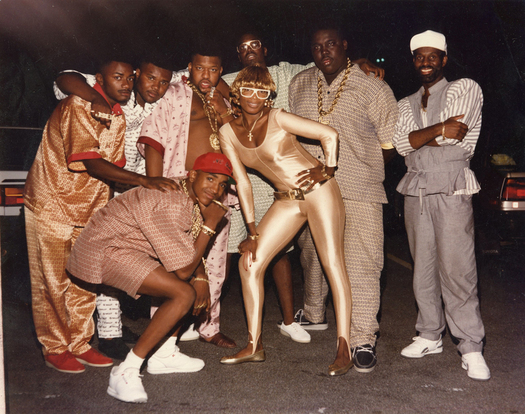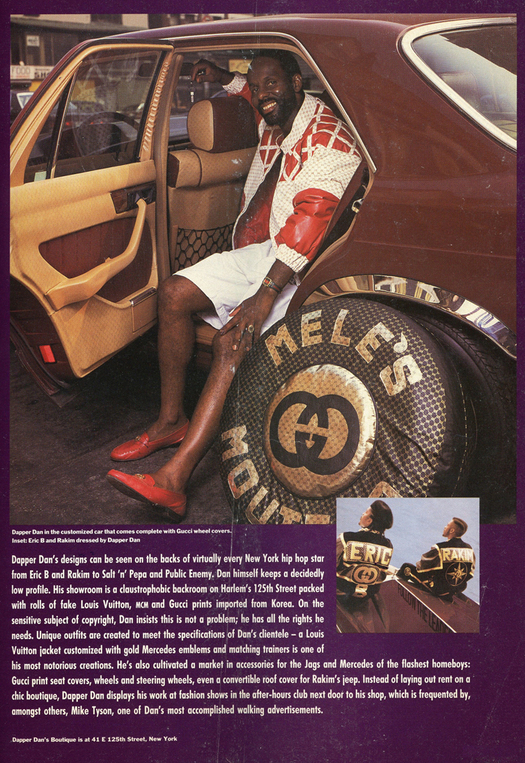I was pleasantly surprised the other day to encounter this item announcing the first interview from Dapper Dan in more than 20 years. Ever heard of him? If not, he’s worth knowing about.
His basic story is recounted in the (video) interview, evidently for a YouTube channel associated with Jay-Z, called Life + Times. As “Dap” tells it, luxury retailers didn’t want him as a customer, so he figured out how to replicate and — crucially — riff on, their wares. This led to his role in helping create the lux-logo-soaked spectacular style (in the Dick Hebdige sense of spectacular style) associated with early rap culture. The video is here. There’s also a newish related Tumblr: Dapper Dan’s Boutique.

One reading of Dapper Dan's work is that was meant to subvert luxury logos. Another is that he was in the knockoff business. I don’t think either reading quite gets it. This was a culture interested in seizing and taking a kind of ownership of a certain strain of branding, not in undermining it. And merely creating imitations of actual luxury-brand offerings would not have achieved that goal: The logos became elements of new creations (not simple imitations) that the relevant corporate owners quite likely opposed.
Still, Dapper Dan was clearly appropriating luxury symbolism to his own ends: A brand like Gucci would be unlikely to create tire covers, or the jacket with an oversized version of its mark that Eric B wears on the cover of the 1988 album Follow The Leader. And I'm guessing that Fendi was not producing head-to-toe logo outfits along the lines of those pictured above. Luxury branding, after all, tends to be about subtlety, not spectacle.

And it's no surprise that, as Dapper Dan notes in this interview, everybody sued him. (He also mentions at least one example of what he describes as a straight-up knockoff: “the same jackets that they wouldn’t sell me.”) Apart from trademark infringement, the brands surely objected, and not unreasonably, to an unwlecome association with the drug trade — see this video clip from the VH1 documentary Planet Rock: The Story of Hip Hop and the Crack Generation, which suggests that early rappers picked up on Dapper Dan from high-roller dealers.
I showed the Dapper Dan Life + Times video to some students recently, and was somewhat taken aback at how negative many of the reactions were, from disapproval of unauthorized logo appropriation to distaste for some of the gaudy results. Sure, some of this stuff looks as dated as a tie-dyed shirt or a safety pin through the nose. But I think that critique gets in the way of recognizing this stuff as highly worthy of attention from anybody interested in the intersection of aesthetics, class, and culture. It was, by any standard, a fairly radical reimagination of style, one that matched the visual-signifier theatricality of punk, and recognized and redefined the logo as a symbol of power and meaning a generation before legions of “streetwear” designers built their own brands on a highly similar epiphany. Moreover, the wild exaggeration of high-end signification to the point of something that might look like parody to some observers opens up this style to the same kind of critical speculation that has long surrounded, say, the zoot suit.
Maybe the results look tacky through today’s eyes, and I suppose the intellectual-property theft is undeniable. But in his way, what Dapper Dan did was wholly original.
* *
A footnote: The Smoking Section item that brought the Dapper Dan video to my attention got on my radar by way of a Google alert: I have one of those recurring “vanity” searches on my own name, and the item notes in passing my mention of Dapper Dan in Buying In. (It’s just a couple of pages — I really wanted to interview him, but failed.) The point is that a vanity Google search can actually be useful; the power of self-absorption!
More seriously, I want to give credit to the organizers of 2006 exhibition at the Museum of the City of New York, titled Black Style Now. That show included several Dapper Dan pieces, and more information about him and his work than I had ever encountered at the time. Susan Scafidi wrote up the exhibition on her Counterfit Chic blog back then, here.


Comments [1]
11.15.12
08:11